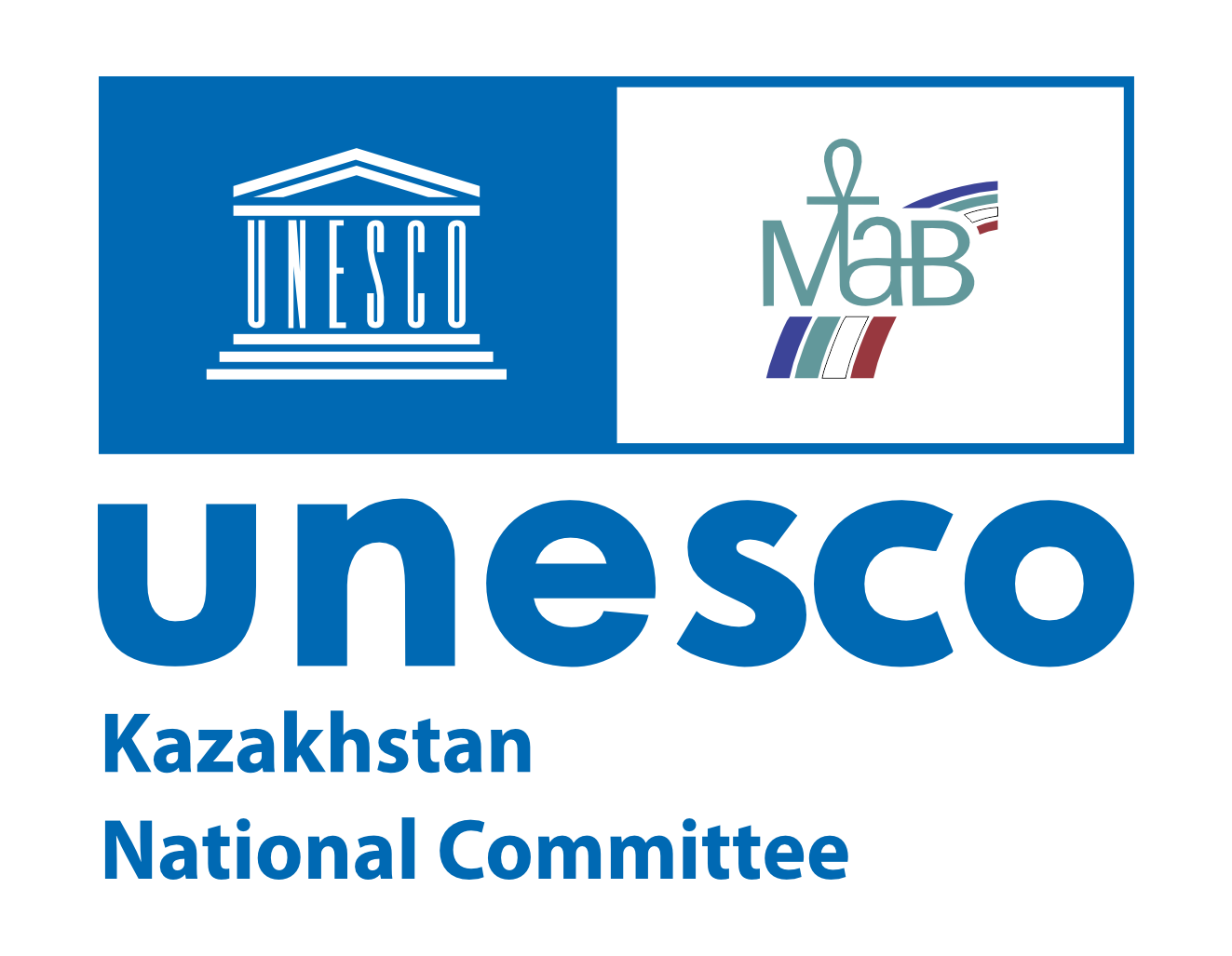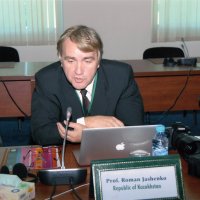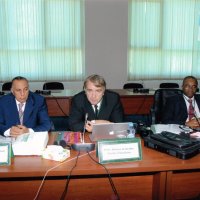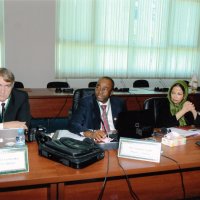ISESCO Генеральная конференция. Марокко 2012 - ISESCO Генеральная конференция. Рабат Марокко 2012
ISESCO Генеральная конференция. Рабат Марокко 2012
По приглашению Научного директората ИСЕСКО с 3 по 4 мая 2012 в Рабате (Марокко) Ященко Р.В. (председатель казахстанского национального комитета МАБ) принимал участие в работе региональной конференции «Глобально важные для Всемирного наследия сельскохозяйственные системы в исламских странах», которая было подготовлена совместно ИСЕСКО и Организацией ООН по пищевым продуктам и сельскому хозяйству (FAO). Кроме этого, в первую половину дня 3 мая там же проходила торжественная церемония празднования 30 летнего юбилея ИСЕСКО. Оба события проходили в штаб-квартире ИСЕСКО в г. Рабат.
Торжественное собрание по случаю 30-летнего юбилея ИСЕСКО проходило в зале исламской солидарности ИСЕСКО при участии делегаций стран членов ИСЕСКО, официальных лиц правительства Марокко и многочисленных представителей прессы и телевидения. После традиционного чтения одной из сур Корана, премьер-министр Марокко зачитал приветственное слово короля этой страны Мухаммеда VI и выступил с торжественной речью от имени правительства своей страны. После него обзорный доклад о достижениях ИСЕСКО сделал его генеральный директор этой организации. В конце торжественной церемонии был показан документальный фильм об истории становления и основных исторических событиях, связанных с деятельностью ИСЕСКО. Очень приятным моментом была демонстрация в фильме и некоторых сцен визита президента РК Н.А. Назарбаева в Марокко – беседа с королем Марокко, посещение штаб-квартиры ИСЕСКО в Рабате и момент подписания соглашения о вступлении Казахстана в ИСЕСКО. Вместе с тем, благоприятное впечатление об этом документальном фильме было омрачено неудачным подбором музыкального сопровождения. Дело в том, что на протяжении всего фильма в прекрасном исполнении симфонического оркестра звучала 3-я часть сонаты си минор Ф. Шопена, которую в постсоветских и многих европейских странах играют часто на гражданских панихидах и, как правило, при выносе тела усопшего. Такое несоответствие видео и музыкального ряда создавало ощущение фантасмагории, нереальности и комичности. К сожалению, здесь не была учтена разница в восприятии отдельных музыкальных произведений носителями различных национальных культур. Если в сугубо мусульманской восточной среде никаких недоуменных вопросов к музыкальному сопровождению не возникало, то у многих евразийцев такая работа музыкального редактора вызвала бы в лучшем случае улыбку. После окончания церемонии во время праздничного фуршета Ященко Р.В. подошел к ведущему собрания (один из сотрудников ИСЕСКО) и объяснил необычность ситуации, а также попросил заменить музыку в фильме, который планируют показывать в различных странах мира, на более жизнерадостную.
Вторая половина дня 3 мая и весь день 4 мая были посвящены работе конференции ИСЕСКО и ФАО. Участниками встречи являлись эксперты из нескольких стран ИСЕСКО (Марокко, Алжир, Тунис, Ливия, Египет, Сенегал, Бенин, Иран, Пакистан), а также представители центрального (г. Рим) и региональных (Рабат, Тунис) офисов ФАО. Председателем собрания был избран министр пищевой безопасности и исследований Пакистана г. М. Моазам Али Хан Ятои (M. Moazzam Ali Khan Jatoi). Основной целью конференции было объединение усилий ИСЕСКО и ФАО для продвижение в мусульманском африкано-азиатском регионе инициативы по созданию системы глобально значимого сельскохозяйственного наследия (GIAHS – Globally Important Agricultural Heritage System, http://www.fao.org/nr/giahs/en/ ). С основным и обзорным докладом по программе GIAHS выступил директор отделения земли и воды ФАО г. Парвиз Кохафкан (Parviz Koohafkan, FAO, Rome). После этого критерии отбора сельскохозяйственных территорий осветила в своем выступлении г. Мари Делакруз (Mary De La Cruz, FAO, Rome). Остальные доклады носили отчетных характер по выявлению потенциала региона для номинирования GIAHS. После активного участия члена казахстанской делегации в дискуссиях первого дня и по причине важности участия РК в программе GIAHS Ященко Р.В. было предложено на второй день сделать незапланированный заранее доклад о потенциале участия Казахстана в программе, который был сделан на следующий день. В ходе дискуссий и своей презентации Ященко Р.В. указал на концептуальную близость программы МАБ ЮНЕСКО и GIAHS, которые в своих подходах схожи т.к. транзитная зона в биосферном резервате соответствует критериям GIAHS. Вследствие этого, он предложил объединить усилия МАБ и ФАО и также предложил деятельность GIAHS-ISESCO в наших странах осуществлять на национальном уровне через Национальные комиссии ЮНЕСКО и ИСЕСКО в каждой стране.
В конце конференции и после интересных многосторонних обсуждений по структуре программы, совместной работе ФАО и ИСЕСКО и потенциала региона в создании системы GIAHS был выработан черновик резолюции, охватывающий все рассмотренные вопросы и намечающий план дальнейшей совместной деятельности. После редакторской доработки эта резолюция будет разослана среди участников конференции.
В целом, конференция была плодотворной и открывает возможности расширения сотрудничества стран членов ИСЕСКО в рамках программы ФАО.
Ниже приводится рабочая программа конференции на английском языке.
Concept Note
Collaborative Forum on
Globally Important Agricultural Heritage Systems
In Islamic Countries
“Theme: Culture and AgriCulture for Sustainable Development”
Organized Jointly by ISESCO and FAO
ISESCO Headquarters, Rabat, Kingdom of Morocco
3 - 4 May 2012
- Background Note
Worldwide, specific agricultural systems and landscapes have been created, shaped and maintained by generations of farmers and herders based on diverse natural resources, using locally adapted management practices. Building on dynamic local knowledge and experience, these ingenious agricultural systems reflect the evolution of humanity and its profound harmony with nature. The patient work of generations of farmers around the world has also resulted in sites of outstanding aesthetic beauty, reservoirs of globally significant agricultural biodiversity and valuable cultural inheritance, and, above all, a magnificent source of goods and services, food and livelihoods security for millions of poor and small farmers.
These systems are merited as Globally Important Agricultural Heritage Systems. GIAHS represent a continuation of historic culture, traditions and knowledge that have evolved over the centuries. These cultures, settlements, landscapes and habitats have suffered dramatically in the wake of industrial and agricultural revolutions and advances in science, technology, commerce and communications in the nineteenth and twentieth century and recently from the impact of environment degradation however, they are still surviving as flag bearers of unique and diverse culture, traditions and remarkable landscapes around the world. The conservation and revitalization of these agri-culture systems is in time and also crucial to find answers to the most current and future global development challenges, such as rural poverty, exodus towards megalopolis, exclusion of local economies from international markets, depletion of natural resources and the vertiginous loss of biodiversity.
Against this background, in 2002, during the World Summit on Sustainable Development (WSSD, Johannesburg, South Africa), the Food and Agriculture Organization (FAO) of the United Nations launched a Global Partnership initiative on Conservation and Adaptive Management of Globally Important Agricultural Heritage Systems (GIAHS). The overall goal of the partnership is to identify and safeguard Globally Important Agricultural Heritage Systems and their associated landscapes, agricultural biodiversity and knowledge systems through catalyzing and establishing a long –term programme to support such systems and enhance global, national and local benefits derived through their dynamic conservation, sustainable management and enhanced viability.
Of great importance and relevance to GIAHS Initiative is the Islamic Educational, Scientific and Cultural Organization (ISESCO), which under its main objectives in the field of education, sciences, culture and communication devotes attention to sustainable argriculture as an important aspect of sustainable production, preserving agrobiodiversity and heritage. New technologies and practices in agriculture specially biotechnologies are promoted to enhance yield production. ISESCO also pays attention to the food and agriculture sectors which are in line with the efforts to address hunger problem and poverty alleviation,as agriculture, forestry and fishies provide nutritious food for all and generate decent income while supporting people centered rural development and protection of environment.
Within this context, FAO and ISESCO has initiated a Partnership Collaboration through a Memorandum of Understanding (MOU)signed between the two organsaitions in November 2011. This partnership is expected to promote the development of agriculture, forestry and fishing as aspects related to science, technology, knowledge and expertise, cultures and assets related thereto, in Islamic countries.
The FAO-ISESCO partnership acollaboration on GIAHS will be launched from 03 to 04 May 2012, during the ISESCO’s 30th founding anniversary meeting in Rabat, Morocco.
- Purpose of the Collaborative Forum
The ISESCO-FAO Collaborative Forum on Globally Important Agricultural Heritage Systems aims primarily to introduce the GIAHS Initiative in Islamic Countries and to facilitate understanding of the significance of culture and agriculture in sustainable development between and among Islamic Countries.
Specifically, the launching will focus on the following objectives:
- Mechanism of FAO-ISESCO collaboration during 2012-2014
- Awareness and understanding of the GIAHS among ISESCO member states
- Present the current status, sites and the preliminary studies of GIAHS in Islamic countries
- Identify the thematic and geographical priorities for the Islamic countries
The Forum will gather representatives from the Islamic member states, selected international organizations, universities and the scientific community, and some representatives of local communities’, donors’ community and FAO staff to discuss strategies for mainstreaming the ‘Agriculture Heritage’ concept at local, national and international levels.
- Provisional Agenda
First Day: 03 May 2012
| 09: 30 - 10:00: | Registration of delegations and participants of Forum |
10:00 – 12:00: |
Celebration of ISESCO’s 30th founding anniversary |
12:30 – 13:00: |
Opening Ceremony of Forum |
|
|
13:00 – 14:00
|
The first session will provide the opportunity to learn more about the ISESCO and FAO Partnerships on GIAHS, the Initiative and its future directions:
Dr Alexander Müller,Assistant Director General, Natural Resources Management and Environment Department, FAO, Rome
|
14:00 – 15:00 |
Lunch Break |
15:00 – 16:00
|
(Dr Mohammad Ait Kadi)
(Dr Jose Esquinas) University of Cordova, Spain |
16:00-17:15
|
Second session: Criteria and Selection of GIAHS and Preliminary Inventory of potential GIAHS in ISESCO member countries
(Dr Noureddine Nasr, FAO |
17:15-17:30 |
Tea/Coffee Break |
17:30 – 18:00 |
Discussion and Open Forum |
18:00 – 18:30 |
Summary and Conclusion |
The second day: 04 May 2012
Third Session: |
Presentation of GIAHS sites |
9:00 – 9:20 |
GIAHS in Algeria |
9:20 – 9:40 |
GIAHS in Azerbaijan |
9:40 -10:10 |
GIAHS in Iran |
10:10 – 10:30 |
Tea/Coffee Break |
10:30 – 10:50 |
GIAHS in Morocco |
10:50:11:20 |
GIAHS in Tunisia |
11:20 – 12:00 |
Discussion and Open Forum |
12:00 – 12:30 |
Presentation of the MOU between ISESCO and FAO |
12:30 – 13:30 |
Lunch Break |
Forth Session |
Working Group Discussion |
13:30 – 15:30 |
Working Groups/Parallel Sessions |
15:30-15:50 |
Tea/Coffee Break |
15:50 – 16:35 |
Presentation of the Working Groups (15 min each) |
16:35 – 17:15 |
Summary and Way Forward |
17:15 – 17:45 |
Closing Ceremony |
- Expected Outcomes and Outputs of the Collaborative Forum on GIAHS
- Awareness raising and promotion of the GIAHS Initiative amongst the participating Isesco countries;
- Identification of the thematic and geographical priorities for GIAHS in the Isesco countries;
- Wider and deeper GIAHS support through an expanded list of partnerships and alliances at national and international levels;
- Two-year workplan (2012-2014) based on the ISESCO-FAO partnership for the region.



